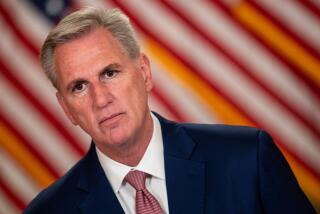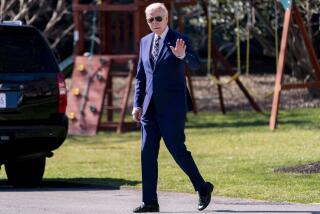Democrats propose an $825-billion bill
- Share via
WASHINGTON — Launching an initiative that could be the cornerstone of Barack Obama’s presidency, House Democrats unveiled an $825-billion spending and tax-cut plan Thursday to shore up the crippled economy.
The measure includes $550 billion for spending on infrastructure, science, energy and education programs over two years, and $275 billion in tax cuts for individuals and businesses. Nearly 60% of the spending would go to state and local governments and nonprofit organizations to pay for things such as schools and healthcare.
While the bill calls for more spending and a smaller tax cut than the president-elect had proposed, it does include the signature tax pledge in Obama’s campaign platform: a credit of $500 for individuals and $1,000 for couples who earn less than $200,000 a year.
“This is a significant down payment on our most urgent challenges,” Obama said of the plan. Democrats said they hoped to enact the legislation by mid-February.
Republicans, who want the stimulus package weighted more toward tax cuts, immediately questioned whether the package included too many items that were not effective stimulus measures. Some said the bill was riddled with pet Democratic programs.
“This legislation appears to blanket government programs in spending with little thought toward real economic results, job creation or respect for the taxpayer,” said Rep. Jerry Lewis (R-Redlands), the ranking Republican on the House Appropriations Committee.
Republicans questioned the inclusion of funding for such programs as the National Endowment for the Arts, $850 million for wildfire prevention and $600 million for new cars for the federal government. Those are a far cry from the traditional economic stimulus tools such as road and bridge construction, to which the bill allots $30 billion, they say.
Democrats say the inclusion of such items reflects their expansive view of how the government can create jobs. Replacing government cars can help the auto industry, for example; hiring people to restore areas ravaged by wildfires can benefit the environment.
Rep. David R. Obey (D-Wis.), chairman of the House Appropriations Committee, called it “the largest effort by any legislative body on the planet to try to take government action to prevent economic catastrophe.”
Said Robert Bixby, executive director of the Concord Coalition, a nonpartisan budget watchdog group: “These may be worthwhile things like healthcare, technology and scientific research. But these are all things that require some long-term strategy. I question whether shoveling money out the door in a stimulus bill is the way to do it.”
The drafting of this bill may provide a glimpse of how the new president will deal with his fellow Democrats in Congress. So far, he has approached them in a collaborative spirit rather than with the kind of top-down style that hurt Bill Clinton when he presented a detailed healthcare plan drafted with little input from Congress.
Obama put forth broad outlines and principles for the economy and worked with Democratic lawmakers to flesh out the details. When Democrats panned one of his tax cuts for employers, he backed down. He wanted to spend less than congressional Democrats did but did not go to the mat over it.
The House Democrats’ inclusion of even fewer cuts than Obama had suggested is a sign they are less inclined to offer olive branches to the GOP. Indeed, some lawmakers in the party complained in closed-door discussions that the bill was too heavy on tax cuts and too light on infrastructure spending.
The goal is for the House to vote on the bill by Jan. 28 and then send it to the Senate, where changes may be made that run up the price tag.
One possibility is a $70-billion measure to shield upper-middle-class Americans from the alternative minimum tax. The AMT was established to ensure that the wealthy do not shelter all their income, but it increasingly has ensnared less-than-wealthy families.
That measure was dropped from the House bill in the face of objections from fiscally conservative Democrats who thought it would do little to stimulate the economy.
“Tax cuts have to be stimulative,” Rep. Jane Harman (D-Venice) said after having lunch with Jason Furman, a top Obama economic advisor. “The infrastructure spending is not high enough for a lot of Democrats.”
The House bill focuses on five main areas: tax cuts for middle-class families; creating jobs through infrastructure investments; assisting people who’ve lost their jobs or health insurance; modernizing and reforming the economy; and assisting state and local governments so they don’t have to cut services further.
Obey said the bill did not contain earmarks -- pet projects for lawmakers’ districts that are inserted into spending bills without normal agency review or approval.
Still, the bill includes a number of initiatives that may not have immediate stimulative effects, but Democrats believe they will make the country and its workforce more globally competitive in the long term.
For example, the bill includes $6 billion for grants to expand high-speed Internet access in rural communities and other underserved areas, $20 billion to jump-start efforts to computerize medical records and $10 billion for science facilities and research.
“Our first obligation is to try to create jobs, but in doing so it doesn’t hurt if we look for areas where we get a ‘twofer’ because you also are making investments that will help people’s ability to raise their family’s income over time,” Obey said.
Republicans are skeptical. Rep. Eric Cantor of Virginia, the party’s second-ranking House member, said he was concerned about the effects of the stimulus bill on the budget deficit. Congress, he said, has to be careful in how it spends taxpayers’ money.
“Right now, what we have is a severe lack of confidence on the part of the American people that Washington can get anything right,” he said.
--
--
(BEGIN TEXT OF INFOBOX)
Stimulus specifics
Breakdown of Democrats’ $825-billion proposal:
Spending
Medicaid: $87 billion in increased funding, with more going to states with high unemployment
Education: $39 billion for school districts and public colleges
Healthcare: $30.3 billion for medical insurance for the unemployed
Infrastructure: $30 billion for highway and bridge construction
Jobless benefits: $27 billion to continue providing up to 33 extra weeks of benefits through the end of the year; also, $9 billion to increase benefits $25 a week
Computerization: $20 billion to computerize health records
Food support: $20 billion for food programs and to lift restrictions on the amount of time people can receive food stamps
Schoolhouses: $20 billion for college and K-12 school construction, renovation, technology upgrades and energy-efficiency improvements
Student aid: $15.6 billion to increase the maximum Pell Grant, the main federal aid program for low-income college students, to $5,350 from $4,850
Aid to disabled: $13 billion for special education programs for people with disabilities
Aid to children: $13 billion for Title I aid for children from low-income families
Grid upgrades: $11 billion to modernize the electricity grid and build new power lines
Tax Credits
Middle class: $500 per worker and $1,000 per couple for families earning less than $200,000 a year
Home buyers: Remove repayment requirement for $7,500 first-time home buyer credit for homes bought in the first six months of 2009
Businesses: Allow businesses to use tax losses to offset profits from the last five years, rather than the current two years
Accountability
Oversight: A seven-member board will oversee the program
Disclosure: Spending and all contract and grant information will be posted on a website created by the president
--
Source: Times research by Scott J. Wilson
--
Financial woes
The U.S. increases its investment in Bank of America. BUSINESS, C1
More to Read
Sign up for Essential California
The most important California stories and recommendations in your inbox every morning.
You may occasionally receive promotional content from the Los Angeles Times.












